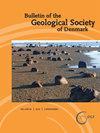Lateglacial and Holocene floras and faunas from the Salpetermosen area, north-east Sjælland, Denmark
IF 1
4区 地球科学
Q2 Earth and Planetary Sciences
引用次数: 3
Abstract
The Salpetermosen area in north-east Sjælland, Denmark, was deglaciated about 18 000 to 17 000 years ago. Melting of bodies of stagnant glacier ice led to the for-mation of kettle holes, which contain Lateglacial and Holocene sediments with remains of plants and animals that provide information on the past flora and fauna of the area. During the Allerød period, open forests with Betula pubescens (downy birch) characterised the area, the flora included light-demanding species such as Arctostaphylos uva-ursi (bearberry), Empetrum nigrum (crowberry) and rare Populus tremula (aspen), Betula nana (dwarf birch) and Rubus saxatilis (stone bramble), as well as the thermophilous swamp plant Oenanthe aquatica (fine-leaved water dropwort). During the Younger Dryas, the vegetation was characterised by dwarf-shrub heaths dominated by Betula nana, but including Dryas octopetala (mountain avens), Salix herbacea (least willow), Arctostaphylos alpina (alpine bearberry,) and rare Betula pube-scens, as well as the thermophilous plants Urtica dioeca (stinging nettle) and Lychnis flos-cuculi (ragged robin). The Early Holocene forests were dominated by Betula pubescens, Populus tremula and Pinus sylvestris (scots pine), but included rare Betula nana. Alnus glutinosa (alder) arrived at c. 10 000 cal. years BP. The calciphilous sedge Cladium mariscus (fen-sedge) and the macrolimnophyte Najas marina (spiny naiad) were common. The Late Holocene flora included the acidophilous plant Scheuchzeria palustris (rannoch-rush).丹麦Sjælland东北部Salpetermosen地区的晚冰期和全新世植物群和动物群
丹麦Sjælland东北部的Salpetermosen地区大约在18000年至17000年前冰川消融。停滞的冰川冰块的融化导致了壶穴的形成,壶穴中包含了晚冰期和全新世的沉积物,以及提供该地区过去动植物信息的动植物遗骸。在Allerød时期,该地区以毛桦树(绒毛桦树)为特征的开放森林,植物群包括对光要求很高的物种,如Arctostaphylos uva ursi(熊莓)、Empetrum nigrum(杨梅)和罕见的白杨(白杨)、Betula nana(矮桦)和Rubus saxatilis(石荆棘),以及嗜热沼泽植物Oenanthe aquatica(细叶水草)。在年轻的Dryas时期,植被以矮生灌木石南为特征,以Betula nana为主,但包括Dryas octopetala(山燕麦)、Salix herbacea(最少的柳树)、Arctostaphylos alpina(高山熊果)和罕见的Betula pube scens,以及嗜热植物Urtica dioeca(刺荨麻)和Lychnis flos cuculi。Alnus glutinosa(alder)于公元前10000年左右到达。喜钙化莎草Cladium mariscus(fen sedge)和大型鲎Najas marina(spiny naiad)是常见的莎草。晚全新世植物区系包括嗜酸植物Scheuchzeria palustris(rannoch rush)。
本文章由计算机程序翻译,如有差异,请以英文原文为准。
求助全文
约1分钟内获得全文
求助全文
来源期刊

Bulletin of the Geological Society of Denmark
GEOSCIENCES, MULTIDISCIPLINARY-
CiteScore
2.80
自引率
16.70%
发文量
28
审稿时长
>12 weeks
期刊介绍:
The Bulletin publishes contributions of international interest in all fields of geological sciences on results of new work on material from Denmark, the Faroes and Greenland. Contributions based on other material may also be submitted to the Bulletin if the subject is of relevance for the geology of the area of primary interest.
 求助内容:
求助内容: 应助结果提醒方式:
应助结果提醒方式:


